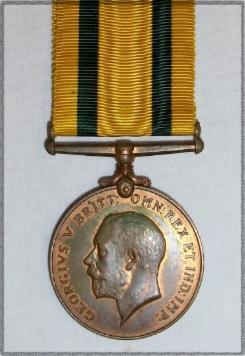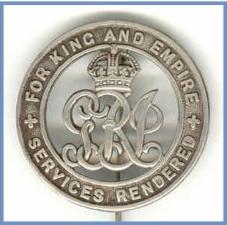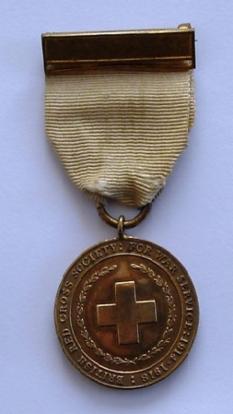THE FAIREST FORCE
21. MEDALS AND AWARDS
*****
BRITISH SERVICE MEDALS
All nurses serving with the British military nursing services overseas received campaign medals in accordance with the criteria laid down and in line with other British officers and men. Details of those campaign medals can be found on the ‘Long, Long Trail’ website here:
British Campaign Medals of World War One
The only variation comes in the award of the Clasp to the 1914 Star. Several hundred nurses were working in support of the British Expeditionary Force during the first few months of the war and qualified for the 1914 Star for service between the 5th August and midnight of the 22nd November 1914. An additional ‘Clasp’ was awarded to men serving with the British Expeditionary Force who both qualified for the medal and also served under enemy fire during the same period. There are known to be nurses’ medal groups displaying the clasp, and although possible that a few members of Q.A.I.M.N.S., Q.A.I.M.N.S. Reserve and the T.F.N.S. met the criteria through service on ambulance trains, it’s unclear whether the award was officially made in any individual cases. As an example, Kate Luard was one of the nursing sisters working on ambulance trains within the qualifying period and was affected by enemy fire. Her medal index card mentions the award of ‘clasp and roses’ with a correspondence reference but lower down the card that reference is repeated, this time with the notation ‘ineligible.’[265] It’s believed that further research is currently being carried out on around twenty-five nurses with a similar employment history to determine whether they were all, eventually, deemed ‘ineligible.’
*****
ROYAL RED CROSS

A short history of the Royal Red Cross in the First World War
*****
MILITARY MEDAL

From June 1916 the award of the Military Medal was extended to women for acts of ‘bravery and devotion under fire’.[267] One hundred and twenty-eight Military Medals were awarded to women from the United Kingdom and the Commonwealth, and another ten to foreign nationals during the Great War. These women were not only members of the nursing services but also members of Queen Mary’s Army Auxiliary Corps, the First Aid Nursing Yeomanry, the Monro Motor Ambulance and some civilians. There has been much controversy over time, particularly from Canadians, as to whether the Military Medal was an adequate reward or if the Military Cross was more suitable for women who, by and large, had officer status. In the autumn of 1918 Miss McCarthy was asked by the Director General of Medical Services, Sir Arthur Sloggett, whether she considered the Military Medal suitable for the nursing staff she controlled.
Received memo from D.M.S., L. of C. forwarding letter from D.G.M.S. with reference to the granting of the Military Medal to Members of the Nursing Service. D.G.M.S. states that from time to time it has been suggested that it is derogatory for Nurses to be given the Military Medal, and that as a class they consider it a stigma to be given a medal reserved for Warrant Officers and other ranks, and that the proper decoration for them is the Military Cross. D.G.M.S. wishes to know the feelings of Nurses generally on this subject, and whether it is advisable to reconsider the necessity of awarding the R.R.C. in future to Nurses instead of the Military Medal.[268]
Her reply, four days later, made her position clear, but this opinion has never met with the agreement of all parties and is still debated in Canada today:
Sent memo to D.G.M.S. with reference to the granting of the Military Medal to Nursing Sisters. Said that with the exception of the Canadian Nursing Service it is felt that no dis-satisfaction exists among Nurses as a whole as regards the award of the Military Medal, and that those who have been awarded this distinction have always fully appreciated it and considered it a very great honour to be given a Medal which is awarded solely for bravery in the field. If this Medal were replaced by the R.R.C., which is now given in such large numbers at Home and Abroad, it would in my opinion, be a sad pity. Also the Military Medal is now an additional distinction.[269]
For a full account of the award of the Military Medal to women, and biographies of all British and Commonwealth female recipients in both world wars, a recent book by Norman Gooding is essential reading:
Honours and Awards to Women – The Military Medal, Norman G. Gooding, Savannah Publications, 2013, ISBN 1902366565: EAN 9781902366562
*****
TERRITORIAL FORCE WAR MEDAL

It was granted to members of the Territorial Force and Territorial Force Nursing Service who volunteered for overseas service on or before the 30th September 1914 and who rendered such service during the Great War, and who:
a. Were serving with the TF on the 4th August 1914 or
b. had completed a period of not less than four years’ service with the Territorial Force before the 4th August 1914 and re-joined that Force on or before the 30th September 1914
provided that they:
i) undertook either verbally or by written agreement, on or before the 30th September 1914, to serve outside the United Kingdom, such agreement being operative after the 4th August 1914 and
ii) were passed as physically fit for service overseas between the 4th August and 30th September 1914, both dates inclusive, and
iii) served outside the UK between the 5th August 1914 and 11th November 1918, both dates inclusive, and
iv) did not qualify for the award of the 1914 Star or the 1914-1915 Star
The relatively large number of awards of the Territorial Force War Medal to nurses was due to the fact that nurses were enrolled in the Service from 1909 onwards and by August 1914 there were just under 3,000 active members. Although originally earmarked for home service, from 1913 they could signify their agreement to serve overseas if desired. While a small number travelled overseas with the British Expeditionary Force during the first year of the war, many continued to work in Territorial Force General Hospitals in the United Kingdom and were only transferred overseas later in the war as the number of hospitals increased and staff shortages became more acute. Because of this combination of factors, long-standing members of the Service did not proceed overseas until 1916 onwards, and thus fulfilled all the criteria necessary for the award. Names of all nurse recipients of the TFWM can be found on this page: Territorial Force War Medal Recipients
SILVER WAR BADGE

The nurses’ Silver War Badge medal roll gives details of awards to women who were unable to continue their employment with the military nursing services on account of illness or disability caused by their war service.[271] Only when sorted and put into a database or spreadsheet is it possible to see the number of awards to the separate nursing services and the wider view. Some interesting facts emerge which are not easy to evaluate or understand. Awards to officers and men were covered by King’s Regulations, but as at that time King’s Regulations did not apply to nurses, special conditions were laid down in Army Order 291 of 1918, and for the issue of the King’s Certificate of Discharge in Army Orders 206 and 362 of 1919. The criteria for the award of the Silver War Badge to women, including all nursing staff were:
A second award could be made in cases where women had re-enrolled after the first discharge and again been discharged under the aforementioned circumstances.
There are a total of 735 names on the medal roll. These were spread among Queen Alexandra's Imperial Military Nursing Service, QAIMNS Reserve, the Territorial Force Nursing Service and members of Voluntary Aid Detachments. There are also a handful to civilian women who don't seem to have a place there but could possibly have had some attachment to the military nursing services which is not made clear on the roll itself. From an estimated total of 22,000 trained nurses who served with QAIMNS, its Reserve and the Territorial Force Nursing Service, QAIMNS had a slightly higher proportion of members - about 12,000 to the 10,000 of the TFNS. However, a breakdown of awards into the separate services shows an unequal division:
As many, if not all, of the VAD awards were to members serving in Territorial hospitals, the Territorial Force received well over three-quarters of all SWB awards to nurses. So what was the reasons for this?
Could the Territorial Force Nursing Service members have been physically weaker to start with, or have worked under more challenging conditions? This seems unlikely for such a large and varied group, many of whom were employed in the United Kingdom.
Did the TFNS chiefs at the War Office push harder to get some sort of award for their members on leaving the service, especially if they hadn't served overseas and did not qualify for service medals?
Was there some special TFNS pathway through medical boards to ensure that their members' illness or disability was made attributable to war service?
Did the award of a Silver War Badge make it easier for individual women to claim a pension at a later date - their 'proof' that they were disabled by the war?
Could QAIMNS chiefs have felt that silver war badges for their nurses were nonsense and put obstacles in the way of them applying, or being recommended for such awards?
Were these SWB awards a nonsense? What exactly was the point of them for nurses? As there was no conscription for women they didn't need to prove to anyone that they had 'done their bit.' And why did they continue to be awarded to women right up until January 1922, more than three years after the end of the war? The SWB roll shows that a good proportion of awardees were gainfully employed by the time they received their badges, both in military and civil hospitals. Certainly the uneven division between QAIMNS and the TFNS suggests that it was not simply a case of a woman's health affecting her work but that some administrative minefield worked in favour of members of one service and against members of the other.
I have now added the names of all nurse recipients of the Silver War Badge to a separate page:
Only names and addresses are shown. The medal roll itself also includes the number of the badge and the date of the award, though no reference is made to medical conditions or reasons for discharge. A great number of the trained nurses included in the list have a service record at The National Archives in Class WO399 which can be searched and downloaded online and may add more to individual stories.
*****
SILVER WAR BADGE

a. After service overseas in a theatre of operations with an Expeditionary Force between the 4th August, 1914, and the 11th November, 1918, both dates inclusive, on account of disablement certified under the authority of the Army Council, to have been caused or aggravated by military service
b. On account of disablement certified under the authority of the Army Council to be directly attributable to the action of the enemy, e.g., naval or air raids.
A second award could be made in cases where women had re-enrolled after the first discharge and again been discharged under the aforementioned circumstances.
There are a total of 735 names on the medal roll. These were spread among Queen Alexandra's Imperial Military Nursing Service, QAIMNS Reserve, the Territorial Force Nursing Service and members of Voluntary Aid Detachments. There are also a handful to civilian women who don't seem to have a place there but could possibly have had some attachment to the military nursing services which is not made clear on the roll itself. From an estimated total of 22,000 trained nurses who served with QAIMNS, its Reserve and the Territorial Force Nursing Service, QAIMNS had a slightly higher proportion of members - about 12,000 to the 10,000 of the TFNS. However, a breakdown of awards into the separate services shows an unequal division:
QAIMNS and Reserve --- 131
Territorial Force Nursing Service --- 438
Voluntary Aid Detachment members --- 162
As many, if not all, of the VAD awards were to members serving in Territorial hospitals, the Territorial Force received well over three-quarters of all SWB awards to nurses. So what was the reasons for this?
Could the Territorial Force Nursing Service members have been physically weaker to start with, or have worked under more challenging conditions? This seems unlikely for such a large and varied group, many of whom were employed in the United Kingdom.
Did the TFNS chiefs at the War Office push harder to get some sort of award for their members on leaving the service, especially if they hadn't served overseas and did not qualify for service medals?
Was there some special TFNS pathway through medical boards to ensure that their members' illness or disability was made attributable to war service?
Did the award of a Silver War Badge make it easier for individual women to claim a pension at a later date - their 'proof' that they were disabled by the war?
Could QAIMNS chiefs have felt that silver war badges for their nurses were nonsense and put obstacles in the way of them applying, or being recommended for such awards?
Were these SWB awards a nonsense? What exactly was the point of them for nurses? As there was no conscription for women they didn't need to prove to anyone that they had 'done their bit.' And why did they continue to be awarded to women right up until January 1922, more than three years after the end of the war? The SWB roll shows that a good proportion of awardees were gainfully employed by the time they received their badges, both in military and civil hospitals. Certainly the uneven division between QAIMNS and the TFNS suggests that it was not simply a case of a woman's health affecting her work but that some administrative minefield worked in favour of members of one service and against members of the other.
I have now added the names of all nurse recipients of the Silver War Badge to a separate page:
Only names and addresses are shown. The medal roll itself also includes the number of the badge and the date of the award, though no reference is made to medical conditions or reasons for discharge. A great number of the trained nurses included in the list have a service record at The National Archives in Class WO399 which can be searched and downloaded online and may add more to individual stories.
*****
BRITISH RED CROSS SOCIETY AND ORDER OF ST. JOHN OF JERUSALEM

Other nations also honoured British and Commonwealth nurses who gave humanitarian service to both their civilians and military personnel while serving in France and Flanders. The most common among these were the French Legion d’Honneur, Croix de Guerre, and Medaille des Epidémies, and the Belgian Medaille de la Reine Elisabeth.
*****
[265] First World War Medal Index Cards, The National Archives, WO372/24
[266] Register of the Royal Red Cross, The National Archives, WO145/1, WO145/2 and WO145/3; also available to search by subscription on FindMyPast
[267] London Gazette, 27 June 1916
[268] War Diary of the Matron-in-Chief, The National Archives, WO95/3991, 8 September 1918
[269] War Diary of the Matron-in-Chief, WO95/3991, 12/9/1918
[270] Territorial Force War Medal Roll, The National Archives, WO329/3272
[271] The National Archives, WO329/3253; also available to search via subscription to Ancestry.co.uk